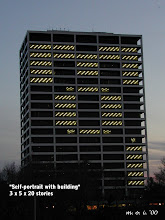
Imagine being tasked with pulling something, something common and everyday, pulling this thing completely apart until there was nothing left. Nothing left at all. Except art. How would you do this? If this sounds daunting, and I believe it to be, then this is largely the task that many of us face every day. We must pull apart our day to make something out it. We want to think that art is different, that it comes from some magical place, deep inside, but really it comes from the painstaking process of pulling things apart until there is nothing left. And then putting them back together. If there's any magic beyond the everyday, it's in the putting back.
Marcie Miller Gross's new work, a part, at Review Studios, offers a glimpse of the difficulty in putting things back together. Coherently. Miller, who has long worked to elevate the everyday object above the pedestrian object, this time takes on the second-hand store sweater. You know the ones. There are racks and racks of them at the your local thrift. Always a gem there if you can find it, the perfect wool sweater, gotten for few dollars when a new one would set you back near a hundred note these days. But how many do you have? Even if you mine the second-hand stores on a weekly basis, the gems are hard to find. Miller takes wool sweaters and then felts them. Not a few, but several hundred. As one who has combed the thrifts stores in search of the thrift store for wool sweaters to felt, I know finding a hundred or so of them isn't easy. Not when color and texture matter, and to Gross, color and texture always matter. Miller said the work evolved as a response to accumulating the materials. This is true of many works, and many art practices, but for her marks an attempt to be more fluid and abstract in her approach to making.
It shows in the work. The earliest piece, ginned from a show several years back, is a small cube of cut and stacked felted pieces. Several hundred small strips come together to make this small cube and it sits atop a stool, much like one might imagine the artist herself has done in the studio, sat on the stool and contemplated, "OK. Now what? Where do we go from here."
Space has also been one of the foundations of her work and here Miller takes ample exception to this one. The Review gallery space is best thought of as only half a space. The remainder seems unconnected. Gross makes a valiant effort to pull in the steel pillars and make them part of a more serene and contemplative space that Gross's work evokes.
One might best think of these colors, these thousand colors, as a mediation on the whole, rather than on a part of the whole. They attempt to establish a relationship between what they once were and what they are now. And in the process, they lose every part of what they once were, and define something new. This is were the subtly of art lies, in creating that new space, between those spaces that existed before, but which you never noticed. The post war movement mono-ha in Japan also worked on these edges and Miller Gross references them in her artist statement.
Tuesday, May 27, 2008
marcie miller gross @ review studio
Posted by
Warrior Ant Press Worldwide Anthill Headquarters in Kansas City, Missouri, USA.
at
6:05 AM

Subscribe to:
Post Comments (Atom)





No comments:
Post a Comment